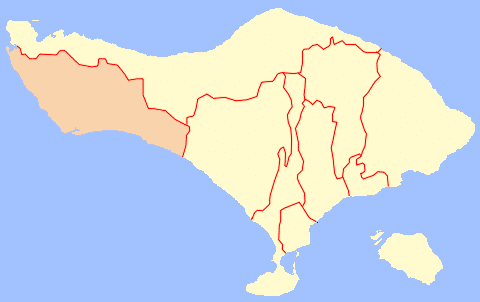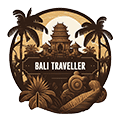Jembrana Regency is a regency (kabupaten) of Bali, Indonesia, located in the southwest. It has a land area of 841.8 km2 and a population of 317,064, according to the 2020 Census. Negara is the regency seat.
Tourists are usually somewhat unfamiliar with Jembrana. When most people arrive in Bali from Java, they drive down the coast route.
The majority of tourists go directly to their hotels in Bali’s south. However, Jembrana has several exciting tourist attractions.

Overview
Gilimanuk Bay serves as Bali’s western seaport. Gilimanuk is the port that serves the ferries that go between Java and Bali.
The Bali Strait’s waters are tranquil and ideal for water sports. The sun rises behind Mount Sangiang, also known as Klatakan.
Baturiti is a mountainous region with a stunning natural environment with several hills and green trees. Bull races can be seen in the little hamlet of Negara.
Yeh Embang village is 10 kilometres from Negara, and Rambut Siwi temple is to the east. This is the largest temple in Bali’s western region. The temple is located 300 metres from the road leading to Jembrana.
Aside from the temple, the surrounding sea and paddies are also appealing.
Not far away is Perancak, a recreation park with a fishing pond. Here is the location of the Perancak Temple. On the beach, there is a fishermen’s hamlet.
Asah Duren hamlet is located in a mountainous terrain 20 kilometres from Negara. This region is home to clove trees. Medewi Beach is around 10 kilometres away.
Districts of Jembrana Regency
| Name | Area in km2 | Population 2020 Census | Number of villages |
|---|---|---|---|
| Melaya (a) | 197.19 | 61,494 | 10 |
| Negara | 126.50 | 95,539 | 12 |
| Jembrana | 93.97 | 61,812 | 10 |
| Mendoyo | 294.49 | 67,536 | 11 |
| Pekutatan | 129.65 | 30,483 | 8 |
| Totals | 841.80 | 317,064 | 51 |
History of Jembrana Regency
This regency is said to have been created in the early 1400s, but due to civil war, it was absorbed into the Badung regency. In the 17th century, the sparsely populated Jembrana was of little concern to the royal Balinese Kingdoms, and it was controlled for a while by a Sulawesi prince. In the 1800s, Jembrana was one of the first kingdoms to capitulate to the invading Dutch.
Interesting Locations in the Jembrana Regency
- Asah Duren: The route climbs into the foothills twenty kilometres inland from Negara. Large clove plantations surround the community of Asah Duren. Before, the main clove-growing locations in Indonesia were Sumatra and Maluku, but in the last decade, Bali has emerged as a significant producer.
- Baluk Rening Beach: The annual Jukung races take place on this beach in August—a beach with a western orientation and excellent sunset views.
- Boats in the Madurese style: These brightly coloured boats grace the coasts of Negara’s south and southwest. The best site to watch them during the day (they often fish at night) is near the village of Pangambengan, about seven kilometres southwest of Negara town.
- Bunut Bolong: A sacred banyan tree grows over the road, or rather the road runs through it, up into the foothills of west Bali, towards Pupuan. The surrounding region is a tropical forest with numerous magnificent trees.
- Buffalo races (Mekepung) in Delod Berawah: Approximately 9 kilometres east of Negara town: Mekepung thought to have originated in Madura, was initially held as part of Negara’s harvest celebrations. Every second and fourth Sunday at 7 a.m., the colourfully adorned carts and buffaloes compete on a four-kilometre route—Negara’s major attraction, without a doubt.
- Bugis Houses: Look for the architecturally distinctive Bugis houses across Negara, particularly in the Loloan Timur district. Those who have visited southern Sulawesi will have a sensation of déjà vu.
- Candikusuma Beach: Expansive broad beach with views of Java. The local populace flocks here on weekends and holidays.
- Cekik: A prehistoric village located immediately south of Gilimanuk (Circa 1000BC). The National Park’s headquarters and visitor centre are located here.
- Delod Berawah Beach: A popular beach featuring bull and horse races on the weekends.
- Folk Dancing and Bamboo Music: Many coffee plantations may be found in the northern section of West Bali, near the Jembrana border. The Joged Bumbung music and dance groups are supposed to have originated here. Such types of flirtatious dance performances are becoming prevalent throughout Bali.
- Gilimanuk: This is Bali’s westernmost town and the ferry terminal for anyone intending to cross to Java. The peaceful bay is ideal for water activities and is the closest spot to stay if visiting West Bali National Park.
- Jegog: A large bamboo gamelan (orchestra) is typical to Jembrana and rarely heard outside the regency.
- Medewi Beach: Long left-handers, famous for surfing, are excellent in the morning before the wind picks up. However, the beach itself is not spectacular. Accommodations from Guesthouses to nicer hotels with pools are available for tourists.
- Negara: A small town located on the main road connecting Denpasar and Gilimanuk. Negara does not have many tourist attractions, but it is famed for its bull racing, which occurs every year between July and October. However, the events’ dates change from year to year. Tickets can be purchased through the Badung Tourist Promotion Board’s office in Denpasar. Water buffalos pull the miniature carts gaily decorated for the occasion down the race track at fast speeds. The races, held to commemorate the conclusion of the rice harvesting season, are judged on both speed and style and produce an astonishing spectacle, watched by crowds of locals as the bulls thunder down the tiny mud track, bells ringing and silken banners flying.
- Palasari and Blimbingsari: The landscape becomes more mountainous west of Negara, towards Gilimanuk, with beautiful views of West Bali National Park. The entire area is sparsely populated, with the villages of Blimbingsari and Palasari of particular interest. Both were cut out of the forest by trailblazing Christian pioneers, the former a protestant town and the latter a Catholic community. Being Christian, the towns are highly impacted by Balinese culture. There are epic plays and dances, for example, in which the regular Hindu characters are replaced with those from the Bible. These communities are easily accessible from the main coast road connecting Negara and Gilimanuk at Melayu. Palasari has a massive reservoir with beautiful views of the surrounding hills and mountains.
- Palasari Dam: The dam is ideal for water activities, and the surrounding town of Palasari is home to one of Bali’s few Catholic populations. As a result, the church is pretty unique.
- Pengambengam: The largest fishing port in Bali; is not a port, but the seas are calm, and there are no harmful hazards.
- Perancak: A little town where travellers may watch Bali’s famous buffalo racing. Perancak also has a reptile park and a riverfront temple. Pura Ancak, the village’s historic temple, is named after the Hindu priest Dang Hyang Nirartha, the first to set foot on Bali.
- Rambut Siwi Temple: This little-visited temple is on a low cliff top overlooking a stunning landscape of paddy fields on one side and black sand beaches on the other, roughly halfway between Negara and Medewi Beach. Two caves overlook the sea, each with a view of fishing boats and seagulls above. Dang Hyang Nirartha, the founder of Tanah Lot temple, erected the temple itself. He gave his hair to the temple, according to folklore. As a result, the term Rambut Siwi translates as “Hair Worship.”
- West Bali National Park: This park is home to the endangered Java Deer, the even more endangered Bali Starling, and various other creatures, including the Boss Javanicus, or wild bull.

